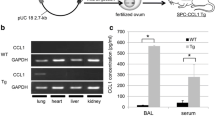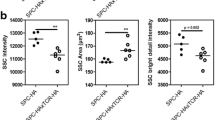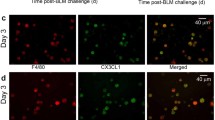Abstract
Purpose
Among different chemokines, monocyte chemoattractant protein-1 (MCP-1) plays an important role in inflammatory disorders of lung. In response to stimuli, MCP-1 increases its transcription as an immediate early gene. In this paper, we describe the MCP-1–enhanced green fluorescent protein(EGFP) transgenic mouse in which EGFP expression is driven by human MCP-1 promoter and mimics the MCP-1 expression in situ. Thus, the MCP-1 reporter mouse model is designed to facilitate a better understanding of its role in various diseases. We employed this mouse model in a pulmonary granulomatous inflammation model using intratracheal instillation of Sephadex (SDX) beads and compared the EGFP reporter expression to endogenous MCP-1 expression through the course of inflammation.
Procedures
We analyzed the temporal pattern of SDX-induced infiltration of inflammatory cells in lung and in bronchoalveolar lavage fluid (BALF). The changes in tissue fluorescence, gene, and protein expressions for both MCP-1 and EGFP were analyzed.
Results
SDX instillation caused massive infiltration of inflammatory cells in BALF and lung tissue at the end of day 3. There was an increase of fluorescence in SDX-treated lung and BALF cells. By using lipopolysaccharide-induced systemic inflammation model, increase of fluorescence was found in bone marrow Gr-1(+) cells with high Mac-1 expression. MCP-1 and EGFP gene expression and MCP-1 protein level were increased after day 1, peaked at day 3, and declined toward basal levels at day 5. In contrast, EGFP protein level peaked after day 3 and remained elevated after day 5. Immunohistochemical staining revealed the MCP-1 and EGFP expression primarily at alveolar macrophages, macrophages infiltrating the granulomatous lesions and in bronchiolar epithelial cells.
Conclusions
By using a pulmonary granuloma model, we showed that EGFP transgene reporter expression in MCP-1-EGFP mouse was correlated to the endogenous MCP-1 induction. The establishment of this mouse model will provide a valuable tool for monitoring the activation of monocytes/macrophages and facilitate the studies on the roles of MCP-1 gene in various inflammatory diseases.









Similar content being viewed by others
References
Boros DL (1978) Granulomatous inflammation. Prog Allergy 24:183–267
Kunkel SL, Chensue SW, Strieter RM, Lynch JP, Remick DG (1989) Cellular and molecular aspects of granulomatous inflammation. Am J Respir Cell Mol Biol 1:439–448
Kobayashi K, Allred C, Choen S, Yoshida T (1985) Role of interleukin 1 in experimental pulmonary granuloma in mice. J Immunol 134:358–364
Tsuji M, Dimov VB, Yoshida T (1995) In vivo expression of monokine and inducible nitric oxide synthase in experimentally induced pulmonary granulomatous inflammation: evidence for sequential production of interleukin-1, inducible nitric oxide synthase, and tumor necrosis factor. Am J Pathol 147:1001–1015
Angel Gonzalo BJ, Lloyd CM, Wen D et al (1998) The coordinated action of cc chemokines in the lung orchestrates allergic inflammation and airway hyperresponsiveness. J Exp Med 188:156–167
Haddad EB, Underwood SL, Dabrowski D et al (2002) Critical role of T cells in Sephadex-induced airway inflammation: pharmacological and immunological characterization and molecular biomarker identification. J Immunol 168:3004–3016
Rollins BJ (1996) Monocyte chemoattractant protein 1: a potential regulator of monocyte recruitment in inflammatory disease. Mol Med Today 2:198–204
Ichiyasu H, Suga M, Matsukawa A et al (1999) Functional roles of MCP-1 in propionibacterium acnes-induced, T cell-mediated pulmonary granulomatosis in rabbits. J Leukoc Biol 65:482–491
Sugiyama Y, Kasahara T, Mukaida N, Matsushima K, Kitamutra S (1997) Chemokines in the bronchoalveolar lavage fluid of patients with sarcoidosis. Intern Med 36:856–860
Hashimoto S, Nakayama T, Gon Y et al (1998) Correlation of plasma monocyte chemoattractant protein-1 (MCP-1) and monocyte inflammatory protein-1α (MIP-1α) levels with disease activity and clinical course of sarcoidosis. Clin Exp Immunol 111:604–610
Petrek M, Kolek V, Szotkowska J, Bois RMD (2002) CC and C chemokine expression in pulmonary sarcoidosis. Eur Res J 20:1206–1212
Yoshioka S, Mukae H, Sugiyama K et al (2004) High-BAL fluid concentrations of RANTES in nonspecific interstitial pneumonia compared with usual interstitial pneumonia. Res Med 98:945–951
Chensue SW, Warmington K, Ruth J et al (1994) Cytokine responses during mycobacterial and schistosomal antigen-induced pulmonary granuloma formation. production of Th1 and Th2 cytokines and relative contribution of tumor necrosis factor. Am J Pathol 145:1105–1113
Evaldsson C, Ryden I, Uppugunduri S (2007) Anti-inflammatory effects of exogenous uridine in an animal model of lung inflammation. Int Immunopharmacol 7:1025–1032
Kubin R, Deschl U, Linssen M, Wilhelms OH (1992) Intratracheal application of Sephadex in rats leads to massive pulmonary eosinophilia without bronchial hyperreactivity to acetylcholine. Int Arch Allergy Immunol 98:266–272
Power C, Kobayashi K, Nishimura T, Yoshida T (1994) CD11/CD18 and ICAM-1 expression in a murine foreign body granulomatous lung model. Clin Immunol Immunopathol 73:312–329
Conroy DM, Sirois P (1999) Early bronchial hyperresponsiveness following injection of Sephadex beads in the guinea pig: involvement of platelet activating factor and thromboxane A2. Inflammation 23:437–448
Kishimoto J, Ehama R, Ge Y et al (2000) In Vivo detection of human vascular endothelial growth factor promoter activity in transgenic mouse skin. Am J Pathol 157:103–110
Zhang N, Weber A, Li B et al (2003) An inducible nitric oxide synthase-luciferase reporter system for in vivo testing of anti-inflammatory compounds in transgenic mice. J Immunol 170:6307–6319
Lin KM, Hsu CH, Chang WSW et al (2008) Human breast tumor cells express multimodal imaging reporter genes. Mol Imaging Biol 10:253–263
Lin KM, Hsu CH, Rajasekaran S (2008) Angiogenic evaluation of ginsenoside Rg1 from Panax ginseng in fluorescent transgenic mice. Vas Pharmacol 49:37–43
Fernandez SL, Russell DW, Hurlin PJ (2007) Development of human gene reporter cell lines using rAAV mediated homologous recombination. Biol Proced Online 9:84–90
Tschering T, Janardhan KS, Pubst R, Sing B (2008) Lipopolysaccharide induced inflammation in the perivascular space in lungs. J Occup Med Toxicol 3:17
Koch AE, Kunkel SL, Harlow LA et al (1992) Enhanced production of monocyte chemoattractant protein-1 in rheumatoid arthritis. J Clin Invest 90:772–779
Antoniades HN, Neville Golden J, Galanopoulos T et al (1992) Expression of monocyte chemoattractant protein 1 mRNA in human idiopathic pulmonary fibrosis. Proc Natl Acad Sci USA 89:5371–5375
Gillitzer R, Wolff K, Tong D et al (1993) MCP-1 mRNA expression in basal keratinocytes of psoriatic lesions. J Invest Dermatol 101:127–131
Gonzalo JA, Lloyd CM, Wen D et al (1998) The coordinated action of CC chemokines in the lung orchestrates allergic inflammation and airway hyperresponsiveness. J Exp Med 188:157–167
Kotani J, Avallone NJ, Lin E et al (2006) Tumor necrosis factor receptor regulation of bone marrow cell apoptosis during endotoxin induced systemic inflammation. Shock 25:464–471
Morisaki T, Goya T, Toh H, Nishihara K, Torisu M (1991) The anti mac-1 monoclonal antibody inhibits neutrophil sequestration in lung and liver in a septic murine model. Clin Immunol Immunopathol 61:365–375
Acknowledgments
The authors gratefully thank the technical assistance provided by Shan-Wen Liu, Hsiao-Chi Yu, and Tzu-Chin Wu. This research was supported by NHRI intramural research grants ME097-PP02, NM097-PP06, and ME097-SP07. Taiwan National Science Council grants NSC-96-2627-B-400-001. Subbiah Rajasekaran was supported by NHRI postdoctoral fellowships.
Author information
Authors and Affiliations
Corresponding author
Rights and permissions
About this article
Cite this article
Rajasekaran, S., Kao, V.YY., Chen, MR. et al. Detection of Experimentally Induced Pulmonary Granuloma Inflammation in Monocyte Chemoattractant Protein-1 Reporter Mice. Mol Imaging Biol 12, 163–173 (2010). https://doi.org/10.1007/s11307-009-0261-9
Received:
Revised:
Accepted:
Published:
Issue Date:
DOI: https://doi.org/10.1007/s11307-009-0261-9




